Adaptation of group A Streptococcus to human amniotic fluid
- PMID: 20352104
- PMCID: PMC2843714
- DOI: 10.1371/journal.pone.0009785
Adaptation of group A Streptococcus to human amniotic fluid
Abstract
Background: For more than 100 years, group A Streptococcus has been identified as a cause of severe and, in many cases, fatal infections of the female urogenital tract. Due to advances in hospital hygiene and the advent of antibiotics, this type of infection has been virtually eradicated. However, within the last three decades there has been an increase in severe intra- and post-partum infections attributed to GAS.
Methodology: We hypothesized that GAS alters its transcriptome to survive in human amniotic fluid (AF) and cause disease. To identify genes that were up or down regulated in response to growth in AF, GAS was grown in human AF or standard laboratory media (THY) and samples for expression microarray analysis were collected during mid-logarithmic, late-logarithmic, and stationary growth phases. Microarray analysis was performed using a custom Affymetrix chip and normalized hybridization values derived from three biological replicates were collected at each growth point. Ratios of AF/THY above a 2-fold change and P-value <0.05 were considered significant.
Principal findings: The majority of changes in the GAS transcriptome involved down regulation of multiple adhesins and virulence factors and activation of the stress response. We observed significant changes in genes involved in the arginine deiminase pathway and in the nucleotide de novo synthesis pathway.
Conclusions/significance: Our work provides new insight into how pathogenic bacteria respond to their environment to establish infection and cause disease.
Conflict of interest statement
Figures





Similar articles
-
Transcriptome adaptation of group B Streptococcus to growth in human amniotic fluid.PLoS One. 2009 Jul 1;4(7):e6114. doi: 10.1371/journal.pone.0006114. PLoS One. 2009. PMID: 19568429 Free PMC article.
-
Streptococcus pyogenes Transcriptome Changes in the Inflammatory Environment of Necrotizing Fasciitis.Appl Environ Microbiol. 2019 Oct 16;85(21):e01428-19. doi: 10.1128/AEM.01428-19. Print 2019 Nov 1. Appl Environ Microbiol. 2019. PMID: 31471300 Free PMC article.
-
Analysis of the growth phase-associated transcriptome of Streptococcus pyogenes.Int J Med Microbiol. 2005 Jun;295(3):161-77. doi: 10.1016/j.ijmm.2005.02.010. Int J Med Microbiol. 2005. PMID: 16044856
-
Insights into Streptococcus pyogenes pathogenesis from transcriptome studies.Future Microbiol. 2010 Nov;5(11):1675-94. doi: 10.2217/fmb.10.128. Future Microbiol. 2010. PMID: 21133689 Review.
-
The Amniotic Fluid Cell-Free Transcriptome Provides Novel Information about Fetal Development and Placental Cellular Dynamics.Int J Mol Sci. 2021 Mar 5;22(5):2612. doi: 10.3390/ijms22052612. Int J Mol Sci. 2021. PMID: 33807645 Free PMC article. Review.
Cited by
-
The RD2 Pathogenicity Island Modifies the Disease Potential of the Group A Streptococcus.Infect Immun. 2021 Jul 15;89(8):e0072220. doi: 10.1128/IAI.00722-20. Epub 2021 Jul 15. Infect Immun. 2021. PMID: 33820819 Free PMC article.
-
Analysis of a Streptococcus pyogenes puerperal sepsis cluster by use of whole-genome sequencing.J Clin Microbiol. 2012 Jul;50(7):2224-8. doi: 10.1128/JCM.00675-12. Epub 2012 Apr 18. J Clin Microbiol. 2012. PMID: 22518858 Free PMC article.
-
Pregnancy-related group a streptococcal infections: temporal relationships between bacterial acquisition, infection onset, clinical findings, and outcome.Clin Infect Dis. 2013 Sep;57(6):870-6. doi: 10.1093/cid/cit282. Epub 2013 May 3. Clin Infect Dis. 2013. PMID: 23645851 Free PMC article. Review.
-
Unexplained persistent postpartum palpitations and tachycardia due to Group A Streptococcus.BMC Res Notes. 2015 Nov 30;8:731. doi: 10.1186/s13104-015-1739-y. BMC Res Notes. 2015. PMID: 26619910 Free PMC article.
-
In silico characterisation of the two-component system regulators of Streptococcus pyogenes.PLoS One. 2018 Jun 21;13(6):e0199163. doi: 10.1371/journal.pone.0199163. eCollection 2018. PLoS One. 2018. PMID: 29927994 Free PMC article.
References
-
- Carapetis JR, Steer AC, Mulholland EK, Weber M. The global burden of group A streptococcal diseases. Lancet Infect Dis. 2005;5:685–694. - PubMed
-
- Pasteur L. Septicemie puerperale. Bulletin de l'Academie de Medecine. 1879;8:271–274.
-
- Chuang I, Van BC, Beall B, Schuchat A. Population-based surveillance for postpartum invasive group A Streptococcus infections, 1995–2000. Clin Infect Dis. 2002;35:665–670. - PubMed
-
- Green NM, Zhang S, Porcella SF, Nagiec MJ, Barbian KD, et al. Genome sequence of a serotype M28 strain of group A Streptococcus: potential new insights into puerperal sepsis and bacterial disease specificity. J Infect Dis. 2005;192:760–770. - PubMed
Publication types
MeSH terms
Substances
LinkOut - more resources
Full Text Sources
Molecular Biology Databases

